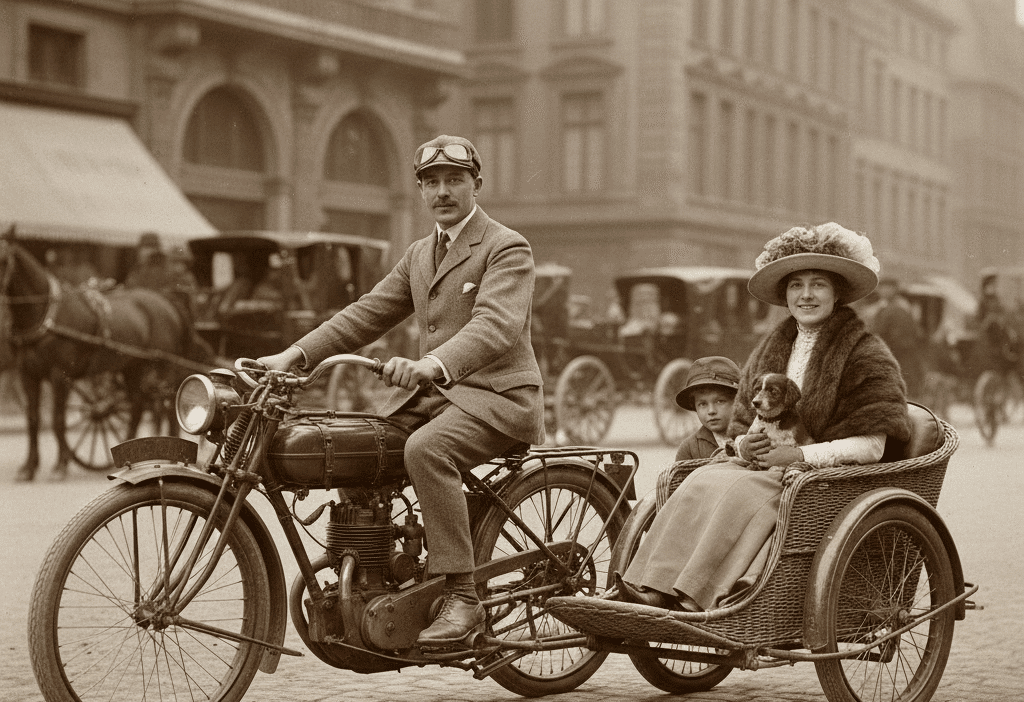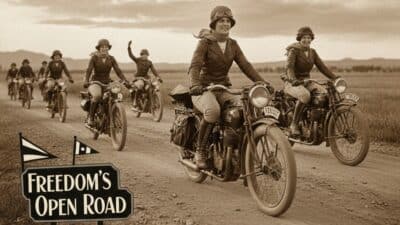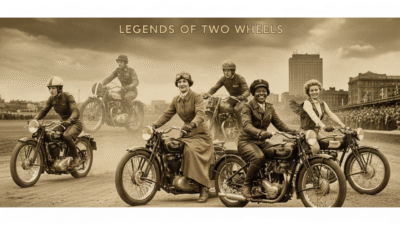Imagine a time when the open road called, and the thrill of two wheels wasn’t quite enough. You needed to carry a friend, a child, or perhaps a trusty canine companion. You desired adventure, but also a touch of practicality. Enter the sidecar: a magnificent, quirky contraption that promised both. It’s a story woven into the fabric of automotive history, a testament to ingenious problem-solving and a bygone era of motorcycling. Let’s embark on a captivating journey to explore the history of sidecars and their decline, tracing their rise from humble utility to dazzling motorsport stars, only to witness their eventual retreat into a cherished, albeit niche, corner of the motoring world.
The Spark of an Idea: Sidecars Emerge
The late 19th century saw the nascent days of motorcycling, a period brimming with innovation and experimentation. As motorcycles gained popularity, a common challenge arose: how to carry a passenger or a significant amount of cargo? Early attempts included tandem riding, but this was often unstable and uncomfortable. The solution, it turned out, was to add a third wheel – and a passenger compartment – to the side.
While the exact “inventor” is debated, the concept of attaching a chair or platform to a bicycle or motorcycle gained traction around the turn of the 20th century. One of the earliest documented designs was patented in 1893 by a French military officer, Jean-Loup Lecerf, for a bicycle attachment. However, it was British inventor W.J. Graham of P.O.C. (Powered One-Cylinder) motorcycles who is often credited with patenting a practical sidecar for motorcycles in 1903. His design, quickly dubbed the “fore-car” due to its position ahead of the rider, soon evolved into the more familiar alongside configuration.
These initial sidecars were rudimentary, often simple wicker baskets or wooden boxes attached to a motorcycle frame. But their impact was immediate and profound. They transformed the solo motorcycle into a versatile, multi-purpose vehicle, expanding its appeal far beyond the lone adventurer. This innovation wasn’t just about adding a seat; it was about opening up new possibilities for personal transport, family outings, and even commercial use.

The Golden Age: From Utility to Icon
The first half of the 20th century marked the undisputed golden age of the sidecar. They weren’t just an accessory; they were an integral part of the transportation landscape. Their versatility made them indispensable during times of peace and, perhaps even more so, during periods of conflict.
Wartime Workhorses
The two World Wars showcased the sidecar’s robust utility like no other period. During World War I, motorcycles equipped with sidecars served as agile, reconnaissance vehicles, messenger transports, and even light machine gun platforms. Their ability to navigate rough terrain and tight spaces made them invaluable on the battlefields of Europe. Motorcycle companies like Harley-Davidson, Indian, and BMW produced thousands of motorcycles with sidecars for military use.
This trend continued into World War II, where sidecar rigs, particularly those from German manufacturers like BMW and Zündapp, became iconic images of wartime transport. Equipped with driven sidecar wheels, they offered surprising off-road capability, ferrying troops, supplies, and communications across vast distances and challenging landscapes. The sidecar’s role in wartime innovation cannot be overstated, as brilliantly detailed in articles exploring how global conflicts reshaped vehicle design and purpose. Read more about this fascinating period in Wartime Wheels: How World Wars Transformed Automotive Technology.
The Family Carrier
Beyond the battlefront, sidecars democratized family travel. In the lean post-war years, when cars were a luxury many couldn’t afford, a motorcycle with a sidecar offered an economical and practical solution for families. It allowed a parent to ride the motorcycle while the spouse and child (or even two children!) could sit comfortably, albeit snugly, in the sidecar. This meant weekend picnics, trips to the market, or visits to relatives became accessible adventures. For many, it was their first taste of motorized family mobility.
Sporting Spectacles
The sidecar also carved out a thrilling niche in the world of motorsport. Sidecar racing emerged as a breathtaking discipline, with specialized outfits designed for speed and agility. The co-driver, often called the “passenger” or “monkey,” plays a crucial role, shifting their weight dynamically to balance the rig through corners, a ballet of muscle and courage. These races, particularly on road courses and purpose-built tracks, drew massive crowds, captivated by the sheer spectacle of these three-wheeled machines leaning into turns at incredible speeds. The skill and bravery of both rider and passenger were, and still are, truly astounding.

The Unique Appeal and Mechanics of a Sidecar
What truly set the sidecar apart was its blend of motorcycle freedom with car-like practicality. It offered an open-air experience, a sense of connection to the road, and the unmistakable rumble of a motorcycle engine, but with the added capacity to carry more than just the rider. This combination made it a unique proposition for those who loved motorcycling but needed more utility.
Riding a sidecar rig, however, is an art form entirely distinct from riding a solo motorcycle. It’s an asymmetric beast, with its own quirky dynamics. Unlike a solo motorcycle that counter-steers and leans into turns, a sidecar outfit remains upright, requiring the rider to steer it more like a car, pushing and pulling the handlebars. This leads to unique handling characteristics:
- Pull to the Sidecar: Under acceleration, the rig tends to pull towards the sidecar.
- Pull Away from the Sidecar: Under braking, it often pulls away from the sidecar.
- Lifting the Wheel: In right-hand turns (for a left-mounted sidecar), the sidecar wheel can lift off the ground if not handled correctly, requiring specific techniques to keep it planted or intentionally “fly the chair” for spectacle.
This learning curve is steep but incredibly rewarding for those who master it. It requires a completely different mindset and set of skills than conventional motorcycling, turning every ride into a thrilling engagement with the machine. Many enthusiasts find this challenge part of the enduring appeal.

Pros and Cons
The sidecar’s unique design offered distinct advantages and disadvantages, which played a significant role in its journey through history.
| Pros | Cons |
|---|---|
| – Allows carrying passengers (including children) or significant cargo. | – Difficult and unconventional handling compared to solo motorcycles. |
| – Greater stability than a solo motorcycle when stopped or at low speeds. | – Slower acceleration and lower top speed due to added weight and drag. |
| – Offers a unique, open-air motoring experience. | – Increased fuel consumption. |
| – Ideal for transporting pets or individuals with mobility challenges. | – More complex maintenance and tire wear patterns. |
| – Distinctive aesthetic and nostalgic appeal. | – Perceived as less safe than a car, and sometimes less agile than a solo bike. |
The Onset of Decline: Why the Shine Faded
By the mid-20th century, the landscape of personal transportation began to shift dramatically. The factors that once made the sidecar an indispensable part of life started to fade, paving the way for its gradual decline from mainstream popularity.
The Rise of the Affordable Automobile
This was, without a doubt, the most significant nail in the sidecar’s coffin. Post-World War II economic booms, coupled with advancements in manufacturing, led to the mass production of increasingly affordable cars. Vehicles like the Volkswagen Beetle in Europe and various compact sedans in the U.S. offered enclosed comfort, superior safety, greater seating capacity, and better weather protection at prices that competed directly with, and soon undercut, the cost of a motorcycle and sidecar combination.
Cars provided more space for luggage, heated interiors, and the ability to transport a whole family in comfort, rain or shine. The public’s preference quickly shifted towards these more conventional, practical, and perceived-as-safer four-wheeled options.
Improved Infrastructure and Changing Needs
As road networks improved and highways became common, the agile, off-road capabilities that once made sidecars so valuable diminished in importance for everyday travel. Cars, designed for speed and stability on smooth, paved roads, simply performed better and more comfortably.
Furthermore, societal expectations evolved. The rugged, somewhat exposed nature of sidecar travel began to be seen as less desirable compared to the enclosed, climate-controlled comfort of a modern car. The sidecar, once a symbol of ingenuity and practicality, started to feel a bit anachronistic.
Safety Concerns and Handling Quirks
While sidecars offer a unique thrill, their unconventional handling characteristics also presented safety challenges. Without the ability to lean into turns like a solo bike, sidecars are more prone to rolling over if corners are taken too quickly or incorrectly. Their asymmetric braking and acceleration dynamics require constant vigilance and a highly skilled rider. As road speeds increased and traffic became denser, these quirks became more pronounced.
Compared to a car with its inherent four-wheel stability, or even a solo motorcycle whose lean provides dynamic balance, the sidecar rig occupied an awkward middle ground. While advancements in automotive safety, from seatbelts to crumple zones, rapidly improved car safety, similar innovations for sidecar rigs were limited. This growing disparity in safety perception contributed significantly to their decline. The automotive industry’s focus shifted dramatically towards accident prevention and occupant protection, as can be seen in the evolution of safety features and regulations. Explore how the industry changed in Safety Revolution: The Innovations That Saved Millions of Lives.

The Niche Resurgence: Modern Sidecar Enthusiasts
Despite their general decline, sidecars never truly vanished. Instead, they retreated into a vibrant, passionate niche, cherished by enthusiasts who appreciate their unique charm, utility, and the sheer joy of riding something truly different.
Retro Appeal and Distinctive Style
Today, much of the sidecar’s appeal lies in its vintage aesthetic and the nostalgia it evokes. A classic motorcycle with a perfectly matched sidecar is a head-turner, a rolling piece of history that commands attention and sparks conversations. This retro chic has fueled a dedicated community of restorers and customizers who breathe new life into old rigs or build bespoke creations.
Specialized Uses and Enduring Practicality
While no longer a mainstream family vehicle, sidecars continue to excel in specific, often heartwarming, roles:
- Pet Transport: For many dog owners, a sidecar is the ideal way to bring their furry friends along for the ride, offering a safe and exciting experience for both.
- Accessibility: For riders with physical limitations, a sidecar can provide the stability and support needed to continue enjoying motorcycling.
- Adventure Travel: Modern sidecars, particularly those from brands like Ural, are renowned for their ruggedness and off-road capability. They are favored by adventure riders who traverse continents, carrying gear and companions to remote corners of the world. For those looking for extreme journeys, understanding vehicle dynamics and careful planning are key, much like tips for safe long-distance driving in any vehicle: Tips for Safe Long-Distance Driving.
- Commercial and Promotional: Their unique appearance makes them excellent for advertising, quirky delivery services, or promotional events, drawing eyes wherever they go.
The Enduring Spirit of Sidecar Racing
Sidecar racing, though niche, remains a fiercely competitive and spectacular motorsport. Events like the Isle of Man TT feature sidecar categories, where teams push their machines and themselves to the absolute limit. These races are a testament to the ongoing evolution of sidecar technology and the incredible skill of the riders and passengers. The passion for this unique form of racing ensures its survival and continues to inspire new generations of enthusiasts.
Modern Manufacturers and Custom Builders
While the number of manufacturers producing sidecars has dwindled, a few dedicated companies keep the flame alive. Ural Motorcycles, originating from Russia (now based in Kazakhstan), is perhaps the most famous contemporary manufacturer, known for its robust, retro-styled sidecar motorcycles, many of which still feature a driven sidecar wheel for enhanced traction. Beyond factory production, a vibrant ecosystem of custom builders and aftermarket companies continues to innovate, creating bespoke sidecar rigs tailored to individual needs and desires, showcasing the creative freedom sidecars offer.

The Future of the Three-Wheeler: Beyond the Traditional Sidecar
The spirit of the three-wheeled vehicle, offering a balance between two-wheeled agility and four-wheeled stability, continues to evolve. While the classic sidecar remains a niche, its legacy has undoubtedly influenced modern three-wheelers.
Trikes and Reverse Trikes
Many contemporary three-wheeled vehicles, often called “trikes” or “reverse trikes,” can be seen as spiritual successors to the sidecar’s concept of augmented stability. Traditional trikes, with two wheels at the rear, offer a more stable platform than a solo motorcycle and are popular among riders seeking comfort and cargo capacity without the complexities of sidecar dynamics.
Reverse trikes, like the Can-Am Spyder or Polaris Slingshot, place two wheels at the front, offering car-like steering and exceptional stability, combining the open-air thrill of a motorcycle with a feeling of grounded security. These vehicles appeal to a broader market, bridging the gap between motorcycles and sports cars and demonstrating how the core idea of three-wheeled personal transport continues to find new expressions.
Electric and Innovative Concepts
As the automotive world moves towards electrification and sustainable mobility, designers are reimagining three-wheeled vehicles with electric powertrains. Concepts for compact, urban three-wheelers, sometimes with enclosed cabins, are emerging, promising efficiency, maneuverability, and a reduced environmental footprint. These modern interpretations might yet see a resurgence of the three-wheeled form factor, albeit in shapes and styles far removed from the vintage sidecar. The future of the automotive industry is ripe with such innovative trends, continually pushing boundaries. Delve into what’s next in The Future of the Automotive Industry: Trends to Watch.
The sidecar’s journey from essential utility to a revered niche highlights the dynamic nature of transportation technology and consumer preferences. While no longer a common sight on every street corner, its influence persists, and its unique charm continues to captivate those who seek an extraordinary riding experience.

Conclusion
The thrilling saga of the sidecar is a captivating tale of innovation, utility, and passion. From its humble beginnings as a practical solution for carrying passengers and cargo, to its indispensable role in global conflicts, and its exhilarating presence in motorsport, the sidecar has carved out a unique and unforgettable place in history. Its decline was not a failure, but rather a natural evolution, as the advent of affordable automobiles shifted the paradigms of personal transport.
Yet, even as mainstream appeal waned, the sidecar refused to fade into obscurity entirely. It found a devoted following among enthusiasts who cherish its distinctive character, appreciate its specialized utility, and revel in the unique challenge and joy of piloting a three-wheeled marvel. The rumble of its engine, the wind in your hair, and the smiles of those in the sidecar remain a testament to an enduring spirit of adventure and individuality. So, the next time you spot a motorcycle with its charismatic companion, take a moment to appreciate the rich history and vibrant legacy of this extraordinary machine – a true icon that continues to inspire and excite. Perhaps it will even inspire you to embark on your own three-wheeled adventure!
Frequently Asked Questions
What is a sidecar?
A sidecar is a one-wheeled vehicle attached to the side of a motorcycle, allowing it to carry a passenger or cargo. It effectively transforms a two-wheeled motorcycle into a three-wheeled vehicle.
When were sidecars most popular?
Sidecars experienced their golden age from the early 1900s through the 1950s, serving as a popular and economical form of family transport and playing crucial roles in both World Wars.
Why did sidecars decline in popularity?
The primary reason for their decline was the mass production of affordable cars after World War II, which offered greater comfort, safety, capacity, and weather protection. Changing social perceptions and the sidecar’s unique, more challenging handling also contributed.
Is it difficult to ride a motorcycle with a sidecar?
Yes, riding a sidecar rig is significantly different from riding a solo motorcycle. It requires a distinct set of skills and a learning curve, as the vehicle doesn’t lean into turns and handles more like a car, with unique dynamics under acceleration and braking.
Are sidecars still produced today?
Yes, a few manufacturers, most notably Ural Motorcycles, still produce complete sidecar motorcycles. Additionally, numerous custom builders and aftermarket companies create and attach sidecars to various motorcycle models for enthusiasts worldwide.
What are modern sidecars used for?
Modern sidecars are primarily used by enthusiasts for recreational riding, adventure travel, transporting pets, providing accessibility for riders with physical limitations, and in niche motorsports like sidecar racing.
How do modern trikes relate to traditional sidecars?
Modern trikes (two wheels at the rear) and reverse trikes (two wheels at the front) are often seen as spiritual successors to the sidecar concept. They offer enhanced stability and passenger/cargo capacity compared to solo motorcycles, appealing to a similar desire for a unique three-wheeled riding experience, though with different handling characteristics.



